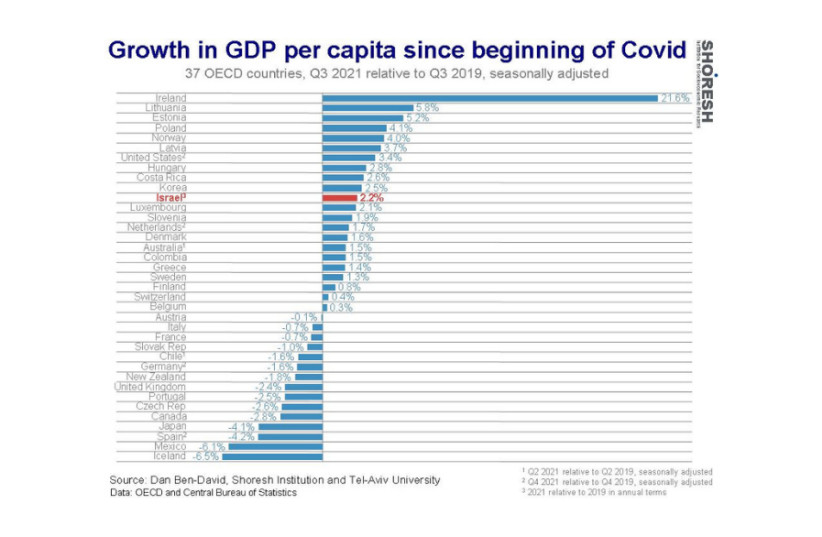As revealed in a report last week from the Central Bureau of Statistics (CBS), Israel’s gross domestic product (GDP) grew rapidly over the course of 2021, to the tune of 8.1%. This reflects a marked increase in the goods and services produced by the start-up nation for the year when compared to 2020 – but this statistic is misleading, as it fails to take into account Israel’s growing population.
“The headlines are very sensationalist; 2020 was a really bad year, so in 2021, we’re coming out of the hole that we were in last year,” said Prof. Dan Ben-David, head of the Shoresh Institution for Socioeconomic Research and an economist at Tel-Aviv University. When faced with the CBS statistic, Ben-David pointed out that “obviously, it looks good; but the relevant comparison shouldn’t be to 2020.” The better question is whether we’re better off or worse off than what we were before we went into the pandemic; and furthermore, if we’re even looking at the right measurements.
Israel has done well recently: its GDP has grown significantly, both when measured from pre-COVID-19 and from just last year. From 2020 to 2021, the increase was a sharp 8.1%; even when measured from 2019, the increase is positive at 5.8%. Professor Karnit Flug, vice president of the Israel Democracy Institute and the former governor of the Bank of Israel, noted that “With a growth rate of 8.1% in 2021, Israel’s economy is among the fastest growing advanced economies among OECD countries.”
“The recovery was led by the high growth of private consumption, but was also driven by an increase in exports of goods and services and an upsurge in investments. The rapid growth was reflected in the rapid decline in unemployment and a rapid increase among those taking part in the labor market,” she added.
However, looking at a dry GDP statistic can be misleading, because it’s also correlated with population increase. In a country like Israel, which has a rapidly growing population, plain GDP isn’t representative of purely financial growth; it’s thrown off by the number of people being added to the workforce. “Most GDP growth comes from population growth, especially in Israel: our population is growing much faster than any other OECD country,” explained Ben-David. “We have 3.1 kids per family versus 2.1 in Mexico, and below that for all the other countries. So we’re getting a huge kick in the growth of GDP, just from the fact that we have a lot of population growth.”

A more accurate statistic to measure growth relative to the size of the country’s population, therefore, is GDP per capita, which removes the population count from the equation, distilling the pure growth of gross domestic product value. By this measurement, Israel is still doing well, but more reasonably: the nation’s GDP per capita grew by 2.2% between 2019 and 2021, which places Israel in the middle of the pack of OECD countries with positive growth over the period.
Noted Ben-David: “Half of the OECD countries that have positive growth are above us, and half of them are below us. Israel’s growth in GDP per capita is positive, but it’s nowhere near spectacular. It’s like right in the middle of the group of the positive.”
With the proper statistics being considered, where is Israel’s growth actually coming from? The data points to the high-rises in Tel Aviv: Israel’s GDP per capita was able to rise as a result of the hi-tech sector’s success. “Under 10% of Israel’s employed persons work in hi-tech, but that sector alone is responsible for half of Israel’s exports of goods and services,” pointed out Ben-David. “It’s carrying an entire country on its back.”
All said, however, a higher GDP per capita doesn’t mean that everyone in the nation is reaping the benefits. In fact, while total private consumption rose by 1.5% since 2019 (due to Israel’s fast population growth), private consumption per capita actually dropped by 2% – indicative of the average Israeli’s financial strain during the pandemic; furthermore, Israel’s homeless population has increased more than 25% from 2020 to 2021, according to the Labor, Social Affairs and Social Services Ministry. Coupled with the current rise in the cost of living, inflation and utilities, there is a ringing dissonance between Israel’s positive growth on paper and the increasing financial distress of its average resident.
